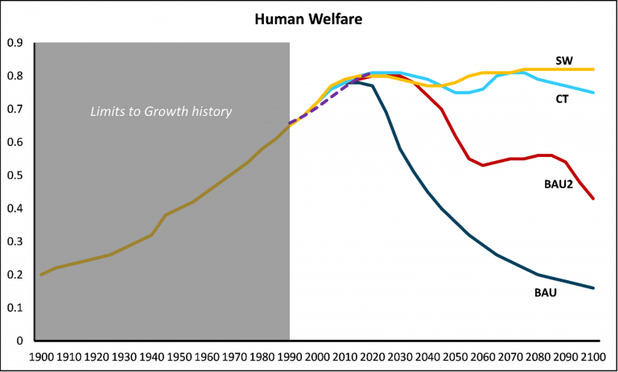Journalist and technology writer Kaif Shaikh disagrees with #GayaHerrington, in this 2025 response. Kaif refers to #JoachimKlement, an economist, who believes that we are already on the way to a collapse, with society returning to the way it was in the 1900s (more about that in another post).
"So, where are we now, and what is the responsible takeaway?
"The 1972 framework still describes the structure of our situation. Herrington’s 2021 comparison shows that the world’s recent history has tracked World3’s growth-first pathways closely enough to warrant concern about declines later this century, potentially beginning to bite this decade. Her 2022 reflection adds two critical refinements. The divergence among futures happens after 2020, and the most livable path requires a conscious redesign of priorities toward efficiency, pollution control, and social investment rather than throughput.
"The Nebel et al. recalibration, as interpreted by Klement, indicates that even after re-estimating parameters with better data, the system still exhibits overshoot and collapse, with the trigger rooted in resource depletion. The implication is that 'more of the same, but faster' is not a strategy. It is precisely what turns today’s creativity into tomorrow’s fragility.
"If there is one message to carry forward, it is Herrington’s: the window for a deliberate trajectory change is narrow but real. The 'Stabilized World' is not a utopian fantasy layered onto a model. It emerges from the same feedback structure that produces overshoot under different goals. Change the goal, and the loops that currently amplify stress can be redirected to reinforce #resilience.
"That change looks less like a silver bullet and more like a portfolio of priorities that the model especially favors. Using fewer resources per unit of well-being, investing in pollution abatement so damages do not accumulate, and building health and education services that improve human welfare without relying on ever-rising material throughput.
"It is also important to be precise about uncertainty. The studies do not claim to know exactly when or how any particular nation will experience stress. #World3 is a global model of dynamics, not a country-by-country forecast. Nor do the authors claim that technology is useless.
"Quite the opposite. Technology can raise ceilings and delay peaks. But as co-author #DennisMeadows has often emphasized in discussions about #LimitsToGrowth over the years, higher peaks without structural change can mean sharper falls (#Overshoots).
"Herrington’s point is that 'technology plus the same goal' keeps us on the wrong curve. Technology deployed in the service of different goals, efficiency, abatement, and human development, separated from material throughput, can move us onto the SW trajectory.
"Finally, the recalibration’s note about system behavior under contraction deserves attention. If the world does tip into decline, feedbacks may rearrange themselves in ways the original model cannot fully capture. That is not a reason to dismiss the warning. It is a reason to move earlier, while our degrees of freedom are greater, and adaptation can be shaped rather than suffered. The studies summarized here do not argue that collapse is inevitable. They suggest that collapse is a real risk if we keep our current goals, and that avoiding it means choosing new ones."
Read more:
https://interestingengineering.com/culture/mit-1972-global-collapse-warning-revisited
Archived version:
https://archive.ph/mUIa2
#SharingEconomy #SolarPunk #Sustainability #Capitalism #CorporateColonialism #Warning #Extinction #ClimateCrisis #EnvironmentalCollapse #Ecocide #Technology #SocietalChange





